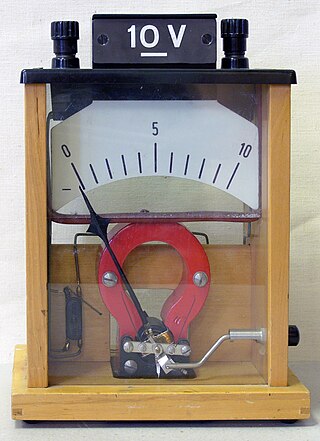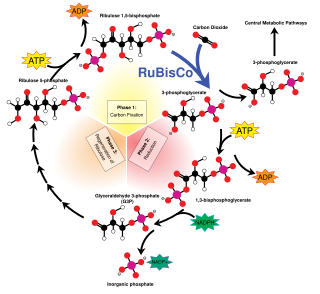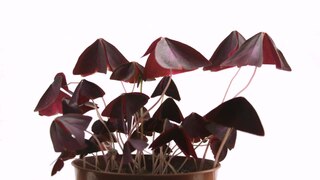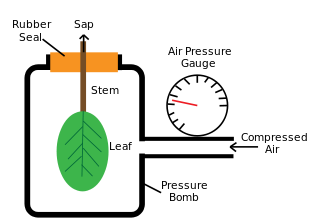
Flowering plants are plants that bear flowers and fruits, and form the clade Angiospermae, commonly called angiosperms. They include all forbs, grasses and grass-like plants, a vast majority of broad-leaved trees, shrubs and vines, and most aquatic plants. The term "angiosperm" is derived from the Greek words ἀγγεῖον /angeion and σπέρμα / sperma ('seed'), meaning that the seeds are enclosed within a fruit. They are by far the most diverse group of land plants with 64 orders, 416 families, approximately 13,000 known genera and 300,000 known species. Angiosperms were formerly called Magnoliophyta.

A voltmeter is an instrument used for measuring electric potential difference between two points in an electric circuit. It is connected in parallel. It usually has a high resistance so that it takes negligible current from the circuit.

An inflorescence is a group or cluster of flowers arranged on a stem that is composed of a main branch or a complicated arrangement of branches. Morphologically, it is the modified part of the shoot of seed plants where flowers are formed on the axis of a plant. The modifications can involve the length and the nature of the internodes and the phyllotaxis, as well as variations in the proportions, compressions, swellings, adnations, connations and reduction of main and secondary axes. One can also define an inflorescence as the reproductive portion of a plant that bears a cluster of flowers in a specific pattern.

Ribulose 1,5-bisphosphate (RuBP) is an organic substance that is involved in photosynthesis, notably as the principal CO2 acceptor in plants. It is a colourless anion, a double phosphate ester of the ketopentose called ribulose. Salts of RuBP can be isolated, but its crucial biological function happens in solution. RuBP occurs not only in plants but in all domains of life, including Archaea, Bacteria, and Eukarya.

C3 carbon fixation is the most common of three metabolic pathways for carbon fixation in photosynthesis, the other two being C4 and CAM. This process converts carbon dioxide and ribulose bisphosphate (RuBP, a 5-carbon sugar) into two molecules of 3-phosphoglycerate through the following reaction:

Caliper(s) or calliper(s) are an instrument used to measure the dimensions of an object, generally by placing two movable points of the instrument across the object or span to be measured.

Root hair, or absorbent hairs, are outgrowths of epidermal cells, specialized cells at the tip of a plant root. They are lateral extensions of a single cell and are only rarely branched. They are found in the region of maturation, of the root. Root hair cells improve plant water absorption by increasing root surface area to volume ratio which allows the root hair cell to take in more water. The large vacuole inside root hair cells makes this intake much more efficient. Root hairs are also important for nutrient uptake as they are main interface between plants and mycorrhizal fungi.
Thermotropism or thermotropic movement is the movement of an organism or a part of an organism in response to heat or changes from the environment's temperature. A common example is the curling of Rhododendron leaves in response to cold temperatures. Mimosa pudica also show thermotropism by the collapsing of leaf petioles leading to the folding of leaflets, when temperature drops.
Photoperiodism is the physiological reaction of organisms to the length of night or a dark period. It occurs in plants and animals. Plant photoperiodism can also be defined as the developmental responses of plants to the relative lengths of light and dark periods. They are classified under three groups according to the photoperiods: short-day plants, long-day plants, and day-neutral plants.
Leaf area index (LAI) is a dimensionless quantity that characterizes plant canopies. It is defined as the one-sided green leaf area per unit ground surface area in broadleaf canopies. In conifers, three definitions for LAI have been used:

In biology, nastic movements are non-directional responses to stimuli, and are usually associated with plants. The movement can be due to changes in turgor. Decrease in turgor pressure causes shrinkage, while increase in turgor pressure brings about swelling. Nastic movements differ from tropic movements in that the direction of tropic responses depends on the direction of the stimulus, whereas the direction of nastic movements is independent of the stimulus's position. The tropic movement is growth movement but nastic movement may or may not be growth movement. The rate or frequency of these responses increases as intensity of the stimulus increases. An example of such a response is the opening and closing of flowers, movement of euglena, chlamydomonas towards the source of light. They are named with the suffix "-nasty" and have prefixes that depend on the stimuli:
Turgor pressure is the force within the cell that pushes the plasma membrane against the cell wall.

Cuscuta campestris, with the common names field dodder, golden dodder, large-seeded alfalfa dodder, yellow dodder and prairie dodder, is a parasitic plant which belongs to the family Convolvulaceae. It was formerly classified in the family Cuscutaceae.

A pressure bomb, pressure chamber, or Scholander bomb is an instrument that can measure the approximate water potential of plant tissues. A leaf and petiole or stem segment is placed inside a sealed chamber. Pressurized gas is slowly added to the chamber. As the pressure increases, at some point the liquid contents of the sample will be forced out of the xylem and will be visible at the cut end of the stem or petiole. The pressure that is required to do so is equal and opposite to the water potential of the sample. Pressure bombs are field portable and mechanically simple, which make them the predominant method for water potential measurements in the fields of plant physiology and ecophysiology.

Acanthochronology is the study of cactus spines or Euphorbia thorns grown in time ordered sequence. Physical, morphological or chemical characteristics and information about the relative order or absolute age of the spines or thorns is used to study past climate or plant physiology.

Chlorophyll fluorescence is light re-emitted by chlorophyll molecules during return from excited to non-excited states. It is used as an indicator of photosynthetic energy conversion in plants, algae and bacteria. Excited chlorophyll dissipates the absorbed light energy by driving photosynthesis, as heat in non-photochemical quenching or by emission as fluorescence radiation. As these processes are complementary processes, the analysis of chlorophyll fluorescence is an important tool in plant research with a wide spectrum of applications.
In molecular biology mir-390 microRNA is a short RNA molecule. MicroRNAs function to regulate the expression levels of other genes by several mechanisms.
In molecular biology mir-529 microRNA is a short RNA molecule. MicroRNAs function to regulate the expression levels of other genes by several mechanisms.
Cell mechanics is a sub-field of biophysics that focuses on the mechanical properties and behavior of living cells and how it relates to cell function. It encompasses aspects of cell biophysics, biomechanics, soft matter physics and rheology, mechanobiology and cell biology.
Francis John Richards was an English plant physiologist who specialized in quantitative studies on the mineral nutrition requirements of crops. He first described the general form of the generalised logistic function in 1959.












